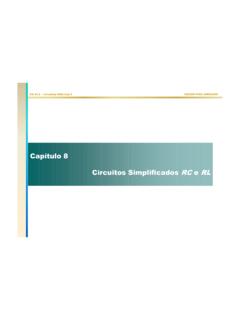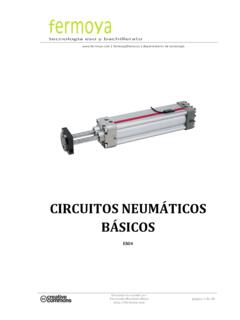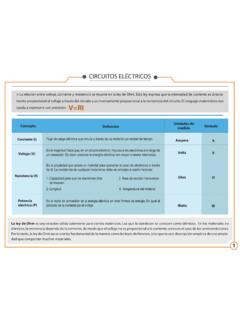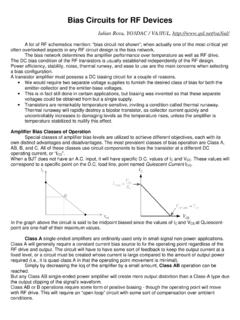Transcription of CIRCUITS WITH RESISTORS, BATTERIES, AMMETERS AND ...
1 WITH RESISTORS, batteries , AMMETERS AND VOLTMETERSELECTRICAL CIRCUITSJaan KaldaVersion: 3rd December 2017 New: idea49, fact8, appendix9, and problems89,106 111; updated ideas47,521 CIRCUITS with resistors, batteries , ammetersand voltmetersThe fundamental physics of CIRCUITS of resistors, batteries , AMMETERS and voltmeters is really simple, and is essentiallycovered with just four laws: the two Kirchoff s laws, Ohm slaw and Joule s law1 formulated here as facts . First, theKirchoff s laws:fact 1:The sum of electrical currents owing into a node2of a circuit is , wires connected to thei-th nodeI = 0;whereIi stands for the current in the -th wire.
2 This assumesthatI is taken with a + sign if it flows into thei-th nodeand with a sign otherwise. We can also say that the sum ofin-flowing currents equals to the sum of out-flowing the electrical current is defined as the charge flowingthrough a wire s cross-section per unit time, this law is essen-tially thecontinuity lawfor electrical charges, combined withthe fact that typically, the capacitance of any wire and any cir-cuit node is negligible3(hence, the charges residing on thenodes and wires can be neglected).For those who are not yet developed good intuition withelectrical currents, the analogy with water flow in branchingrivers or water pipes might be useful: the sum of the waterfluxes (measured in cubic meters of water per second) equalsto the water flux in the main stream.
3 Note that the continuitylaw plays an important role for many physical processes (withgas- fluid or granular flows, but also for traffic fluxes).fact 2:Along a closed loop of an electrical circuit, the sumof voltage drops on the circuit elements (resistors, diodes, ca-pacitors, etc) equals to the sum of the electromotive forces (ofbatteries and inductors).Mathematically, wires forming a closed loopV = 0;where the voltage drop on -th wire is taken with + sign ifthe voltage of the destination node is lower than that of thedeparture node, unless the wire includes an electromotive force(emf.): the voltage drop caused by an emf.
4 Is taken with theopposite law simply states that electrostatic field is a potentialfield; using a mountain-hiking-analogy, if you walk so that youend at the same point from where you started, you ascendedexactly as many meters as you descended. The electromotiveforce of a battery performs work on charge carriers by usingchemical energy (in the case of magnetohydrodynamic generat-ors and inductors/inductor based dynamos, the nature of somewhat different but for the time being, the details are notimportant: practical application of the Kirchoff s laws remainsthe same). With the mountain-hiking-analogy, an electromot-ive force can be considered as a ski-elevator which lifts youupwards and performs a certain work on you each time youuse the mountain-hiking-analogy works only for theKirhoff s voltage law, the channel-network-analogy can be ex-tended to all the direct current phenomena.
5 More specifically,we consider a closed system of water channels; in a channel, thewater flows only downhill, but there are also pumps which raisethe water uphill. Then, there are the following matching pairs:(a) electrical chargeQ mass of waterm; (b) electrical currentIin a wire, defined as the charge flow rateQ=t, whereQis thecharge flowing through a cross-section of a wire during a timeintervalt mass flow rate of water in a channel, defined asm=t, wheremis the water mass flowing through a cross-sectionof a channel during a time intervalt; (c) a battery of electro-motive forceEwhich performs workEQon chargeQ(whichpasses through the battery) a pump which pumps water up-hill, to an heighth, and performs workhmon a pumped watermassm4.
6 Then, obviously, for a closed loop of channels andpumps, the total pumping height ( the sum of the contribu-tions of all the pumps) equals to the total downhill descendingheight in channels ( to the sum of downhill displacements ofall the channels).Next, the Ohm s law:fact 3:Typically, the voltageVbetween the input- and out-put leads (also referred to as theports)5of a piece of electricallyconducting material can be considered to be proportional to thecurrentIthrough it; the coefficient of proportionalityR=V=Iis referred to as its resistance, and the circuit elements of anon-negligible resistance are called us try to interpret this using the pipe-flow analogy.
7 Con-sider a straight pipe connecting two water reservoirs at differentheight. Let us assume that the drag forceFbetween a unitvolume of the flowing water and the pipe s walls is proportionalto the speedvof the flow6:F=kv. Then, the water speedis established by the balance between the dragF=kvandpressure wgh, wherehis the height difference, w the wa-ter density, andg the free fall acceleration. Therefore,vwill be proportional toh, which, according to the analogy, cor-responds to the voltage. Now, let us recall that the currentIcorresponds to the water flux, which equals to the productof the water speedvand pipe s cross-sectional areaS, and istherefore also proportional toh(the counterpart of the voltageV).
8 Such a proportionality is exactly what is stated by theOhm s Kirchoff 1845, Ohm 1827, and Joule 1841, respectively2node(=vertexin graph theory) a point where different wires meet3In the case of very fast or high-frequency processes, this approximation is not valid; then, an equivalent circuit can be used, with ideal wiring andequivalent capacitors and inductors representing the capacitances and inductances of the real we have put the free fall accelerationg= 1which can be done if an appropriate system of units is used5 Ports (input- and output leads) points where the current can enter and exit; often just the endpoints of a is valid for sufficiently thin pipes for which viscous drag dominates over the turbulent one page 1 WITH RESISTORS, batteries , AMMETERS AND VOLTMETERSFor water flow in a narrow pipe, the drag force is propor-tional to the flow speed and to the pipe lengthl, ordinary pipes, the drag force (and hence, the coefficient ) depends also on the diameter of the pipe.
9 However, let usassume that is constant (this would correspond to the casewhen we fill the pipe with a granular material, coarse sand).Pursuing the analogy, the resistanceR=V=Icorresponds tothe ratio of the height differenceh, and water flux. Accordingto the discussions above, this is proportional to the pipe lengthl, and inversely proportional to the cross-sectional areaSofthe pipe (because for a fixedv, the flux is proportional toS).Hence, we arrive at the following 4:The electrical resistance of a wire (of a lengthlandcross-sectional areaS)R= l=S;where is called the electrical resistivity of the wire material( = 1= is called the conductivity).
10 The proportionality law betweenVandIfails actuallyquite often: for instance, in the case of light bulbs, the de-pendence between the voltage and current is nonlinear. Eventhen, the ratioV=Iis referred to as the resistance. In the caseof a non-linearV Idependence, the resistance just dependson the voltage; the derivativedVdtis referred to as the differen-tial resistance. If a circuit element is referred to as a resistor ,its resistance is assumed to be , the Joule s law:fact 5:The power dissipated on a circuit elementP=IV;whereVis the voltage on its leads, andI the current throughit. Alternatively, bearing in mind thatI=Q=t.










